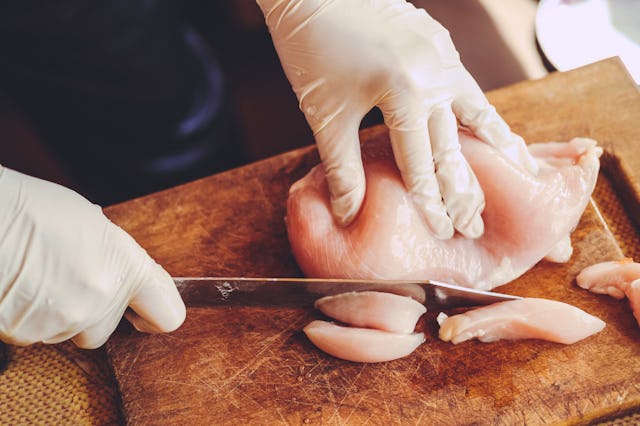PSA From The USDA: Stop Washing Your Chicken
Unless you super-sanitize the sink every time, you could be teabagging anything after the chicken in salmonella.

Every family has its own unique set of practices and traditions in the kitchen. Some kitchen habits — like rinsing your dishes before you put them in the dishwasher or keeping that bowl of bacon grease on the back of the stove — feel like such an ingrained part of your routine that you probably can't imagine not doing them. And in many homes, that includes washing chicken before cooking and consuming it. The hitch? The USDA just published a study demonstrating the dangers of washing raw chicken.
Not surprisingly, this information met mixed reactions on the internet. When Cookist shared the study results on its Instagram account, the comment section quickly filled with people who feel passionately about raw-chicken-washing. The reasoning many folks cite is solid: Raw chicken is gross. Once it thaws, it ends up coated in a layer of its own liquid and slime.
Historically, when people were still raising, slaughtering, and dressing poultry at home, washing raw chicken made sense. But now that most of us get our raw chicken from the grocery store (who gets it from giant, sterilized factories), do we still need to rinse? After all, we have enough to worry about just cleaning our house.
Should you wash your chicken?
Not only is it unnecessary, but The USDA (United States Department of Agriculture) says that rinsing or washing your chicken before you prepare dinner can actually do more harm than good. It all boils down to one terrifying keyword: salmonella.
In partnership with North Carolina University, the USDA researched the practices and cleanliness of 300 participants who washed their raw chicken. The study found that washing chicken increases the risk of cross-contamination, thus increasing the likelihood of foodborne illness.
The response from many has been nothing short of outrage.
"In Europe we all wash chicken. And we all wash our hands and clean all the surfaces before serving. I don't see a problem," one person commented on Cookist's Instagram post.
"You wash your meat and clean the sink. It's as simple as that," insisted another.
But is it that simple?
What happens when you wash your meat?
There are a few myths worthy of busting when it comes to washing chicken. Here's what you need to know.
1. Your poultry and meat aren't dirty.
Your meat comes wrapped in plastic and was most likely handled in-store by someone in gloves and white coats who followed the highest food safety protocol. Before your chicken arrived at the store, it was in a factory where workers and machines held to the highest level of cleanliness and safety cleaned, trimmed, and cleaned your chicken again. The bacteria left in or on meat isn't dirt — it's part of the biological makeup of your meat.
2. Washing your meat doesn't remove bacteria.
Because salmonella and other bacteria are simply part of the makeup of your meat, that means that it doesn't just reside on the outer surface of your chicken. It's in the chicken. It is the chicken. Washing raw chicken might rinse away some of that bacteria... but it doesn't remove all of it.
3. You aren't as clean as you think you are.
During your chicken-washing process, how many times are you moving your chicken? From the container to the sink to the baking dish, at the least. During each of those moves, you could drip on the surfaces in between. Even after you wash your chicken, the water dripping off it before putting it in your baking dish isn't "clean" and free of salmonella.
Not to mention, how strong is your water pressure when you wash? Are there splatters on the dishes drying nearby? The backsplash? The counters? Let's say that every single time you rinse your chicken and place it in the baking dish, you immediately stop to clean. Are you cleaning, or are you sanitizing? And when you "clean up" after you've washed your chicken, are you washing all the way up the sides of your sink?
Sometimes, we let things slide — and leaving salmonella splatters can't be one of them. That's why the USDA warns against rinsing chicken.
How do you ensure your meat is safe to eat?
Washing clearly isn't the answer, whether we all want to admit it or not. If you're willing to give up washing meat, though, what's the best way to ensure your family is safe when eating meat?
First, make sure you're working with clean hands and clean surfaces. It's a good idea to take a sanitizing wipe to all your countertop surfaces and let it dry while you wash your hands before meal prepping. The most important advice to keep in mind when cooking meat? Make sure you're cooking it to the right temperature. (This kills the bacteria inside your meat that washing doesn't get rid of, anyway.)
According to the USDA:
Cook all raw beef, pork, lamb, and veal (steaks, roasts, and chops) to a minimum internal temperature of 145°F. For safety and quality, allow meat to rest for at least three minutes before carving or consuming.
Ground meats are safe to eat at 160°F. For burgers, insert the food thermometer in the side of patties until it reaches the center for an accurate reading.
Poultry products, including whole, parts, or ground chicken or turkey, are safe to eat at 165°F.
Cook fish and seafood to 145°F or until the flesh is opaque and flaky.
For the safest raw chicken handling, place your meat directly from its package into the baking or cooking dish. Use gloves or a fork to handle raw meat. And always, always, wash your hands after handling raw meat or anything that comes in contact with it, like the packaging.